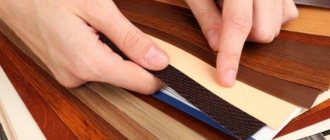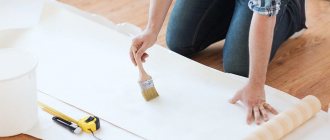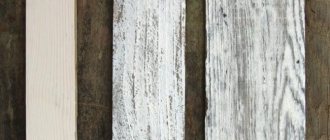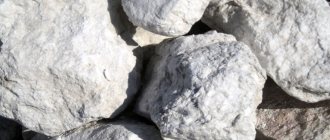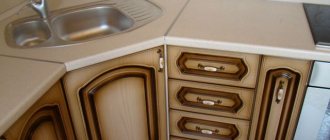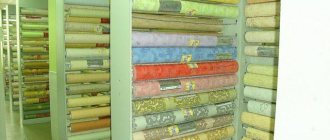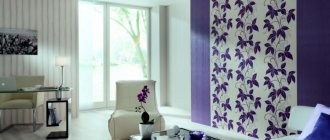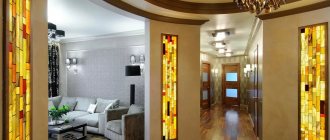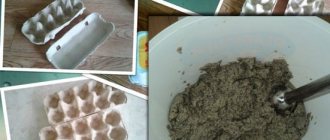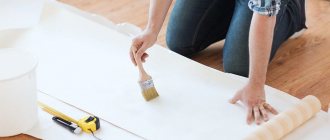Man is designed in such a way that he needs to periodically update his environment. If finances allow, this can be done by purchasing new furniture. But if the family budget does not allow for such expenses, then simply update the façade of the old set using self-adhesive film.
With its help, you can give furniture a new look and eliminate defects that appear during its operation.
Recently, self-adhesive film intended for various furniture has become increasingly popular.
What is self-adhesive film
Self-adhesive is an excellent option for refreshing furniture that has become outdated over time. To do this, you only need the material itself and sharp scissors or a construction knife. There are special compartments on the inside of the product, making it easy to cut it into rectangles and squares of the desired size.
Using this idea, you won’t spend a lot of time and will be able to implement it yourself.
The material is easy to care for and can be treated with detergents and gels. Furniture covered with film is protected from scratches and chips. It is durable and has an attractive appearance. Anyone can glue furniture on their own; no special skills are required.
Gluing to specific surfaces
Plastic, glass and other smooth surfaces will need to be slightly moistened with water and dishwashing detergent before use. When the entire piece is glued, use a rag to remove water from under the layer. The technique is used when the gluing area is large.
Plastic, glass and other smooth surfaces will need to be slightly moistened with water and dishwashing detergent before use.
Adhesive film is an affordable and practical option to update outdated furniture. Can also be used as sun protection and glass tinting. A wide range of products makes it possible to choose a film for any interior.
Types and types of films for furniture
The self-adhesive has three width formats - 45 cm, 67 cm, 90 cm. Basically, it has wood, marble, and gloss colors. There are also coatings with various patterns and photo printing. In addition, there is a separate type of self-adhesive - stained glass, intended for pasting windows.
To replace an outdated coating with a new film, you do not need glue.
Colored films for furniture
Colored self-adhesive is available in a wide range of colors. There are no restrictions on its choice for this or that furniture. Therefore, anyone can choose for themselves the option that they like.
How can you independently recognize that the proposed film is really intended for wooden surfaces? Even just based on tactile sensations, you can determine for which surfaces the proposed product is suitable. Furniture film is denser and practically does not wrinkle.
The backing of this material is rough, which does not allow the adhesive surface to deform during the pasting process.
Films for wardrobes, glass and mirrors
Film for fragile surfaces - glass and mirrors, more delicate and thin. It is also called stained glass, as it can transform window openings beyond recognition. However, if you do not follow the operating rules, then during the gluing process such material, unlike self-adhesive furniture, can easily tear. Therefore, only an experienced craftsman can glue stained glass on his own.
For beginners, it is better to use the help of a friend.
To decorate glass products, a translucent matte film is used. It, like furniture, has a wide range of colors and varying degrees of toning - from light drapery to complete blackout.
The only professional skills you will need are patience and accuracy.
Rules for covering furniture with film
There are certain requirements for the selection and gluing of the product.
Choosing a film based on the type of room
If the surface to be treated is in a small room, then it is better to use a mirror coating to visually add volume and space to the room. Naturally, the film will not replace a full-fledged mirror, but the reflective element will still expand the boundaries of the room.
There are a great many options for use. It depends only on your imagination and level of audacity when bringing design ideas to life.
For children's bedrooms, it is better to choose a material in a neutral shade or with images of your favorite cartoon characters. Bright and toxic shades should be avoided not only in the nursery, but also in the adult bedroom. When covering furniture with self-adhesive film in acid tones, you should understand that color accents will constantly be in a person’s field of vision, which will negatively affect the quality of rest.
Self-adhesive film with drawings is an easy way to decorate a child's room.
Self-adhesive with a marble pattern is suitable for bathroom cabinets. A plain surface with a matte or glossy effect will look no less harmonious.
Vinyl film is the most widely used. It is affordable and has a long service life.
Kitchen units are often covered with self-adhesive tape with a wood pattern. For variety, you can select several surfaces and cover them with photographic film with a plant or flower image. For example, cover the kitchen facades with wood textures, and decorate the kitchen apron with a panorama of a field with sunflowers.
Facades decorated with its help are cleaned using detergents and placed in rooms with high humidity.
Required tools and materials
To glue windows or furniture, you will need a minimum set of tools: the film itself, scissors or a stationery knife. You will also need a container with a spray nozzle for irrigating the surface of the furniture to be pasted and a silicone spatula for smoothing the product.
We use only simple, accessible tools - self-adhesive film on a roll, a pencil, a stationery knife or scissors, a ruler.
To prepare a soap solution that promotes the sliding of the material on the surface of the furniture and simplifies the process of fitting it, use ordinary liquid soap and water.
You should also provide for the availability of a workplace in advance. A regular table is suitable for these purposes. If you use a knife instead of scissors, you must also take care to protect the surface of the table to avoid scratches on the product itself and on the work surface.
The surface can be absolutely any - chipboard and MDF, ceramic tiles, plastic, metal.
Furniture surface preparation
How to stick self-adhesive film on furniture? First you need to clean the surface from dust and dirt using cleaning products or plain water. If there is old coating left on the furniture, it is better to remove it. If this cannot be done, then the surface must be sanded so as to smooth out all existing irregularities as much as possible. Next, wipe the surface with water, remove dust and soak with a dry cloth.
It is necessary to prepare the facades to be pasted - remove uneven surfaces, putty, sand, then degrease using window cleaner.
Prepare a light soap solution. Mix water and liquid soap or gel.
Additional Information. There is no exact percentage of liquids, so you can make the solution at your own discretion.
It is better to pour the solution into a container with a spray bottle, so the gluing process will be faster and more convenient.
Next, the composition should be sprayed onto the surface to be treated. The more surface composition we have, the easier it will be to customize the film. During the gluing process, it is also recommended to spray the product with water as often as possible.
Application technology
How to glue self-adhesive film to furniture? In order for the self-adhesive to adhere properly, the surface to be pasted must be clean.
Note! For convenience, there are special markings on the reverse side that allow you to make the cut as accurately as possible.
It is important to remember that you should always cut with a margin of at least 2 cm. When sticking, you do not need to immediately separate the entire film from the protective paper. You should separate approximately 5 cm of the product from one side and carefully apply it to the work surface. After this, you will need to evenly distribute the entire film over the base, gradually pulling off the paper.
Replacing facades using film for pasting is the right, budget option for restoration, for up to 5 years.
As the film spreads, it must be carefully smoothed to prevent bubbles from appearing. This should be done in the direction from the center to the edges. But even if air bubbles do form, they can be eliminated with an ordinary needle.
The big advantage of self-adhesive is that within a few hours after gluing it can be removed and re-glued, since the adhesive base is not fixed immediately.
An important advantage is that you can handle the constriction yourself.
Application technology
Before sticking the self-adhesive film on the furniture, you need to prepare the tools for the job. These include:
- scissors and a sharp utility or construction knife
- soft fabric to smooth out wrinkles;
- roller for removing air from the material;
- solvent;
- primer mixture;
- medium-dispersion sanding paper.
In the process of pasting furniture with film, it is first necessary to prepare the surface of the products by treating them with a special composition. For this, a primer is used, which improves the adhesion of the two planes.
Preparation proceeds as follows:
- tighten all hinges and fasteners of the furniture product. Also check that all screws are screwed in completely; if this is not done, small protrusions will be visible on the glued surface, which will significantly affect the aesthetics of the appearance;
- examine the furniture for cracks and chips. If there are any, they must be removed using putty. Gently apply the mixture to the defect areas and fill the voids. After drying, treat the areas with sandpaper - this will give greater adhesion to the surface to be pasted;
- The next step will be degreasing the plane. Before gluing the film to furniture, soak the fabric in a solvent and go through all the corners and hard-to-reach areas of the furniture panel that will be treated with the material.
When the surface preparation is completed, we proceed directly to the gluing process itself. To avoid shortcomings, follow the proposed algorithm of actions, which can also be found in the video in the article:
- take the necessary measurements of the furniture to cut the required pieces of material;
- using scissors, cut from the roll exactly as much as is necessary for gluing the surface;
- before gluing the furniture panel, remove the material by 10 cm from the protective layer so that the adhesive base is exposed;
- attach a piece of raw material to the furniture with an adhesive layer and gradually, smoothing the film with a roller, remove the remaining material from the protection;
- It is necessary to smooth the plane from the edge that is already glued to the area that you are going to glue. In this way, it will be possible to avoid the formation of folds and wrinkles on the surface being pasted.
There is another method of treating furniture with film, which is based on the use of a wet solution of water and soap. Here, gluing the raw materials correctly will not be difficult. In this case, the protective layer is completely removed and the material is placed on the floor, face down. The solution is applied to the adhesive layer using a sprayer, after which the film is applied to the surface. It is appropriate to stick the material using this method when there are large areas of finishing, when it is difficult to achieve a perfectly smooth surface.
Common mistakes
Those who are faced with gluing film for the first time often make the same mistakes.
Firstly, before purchasing film, you need to take accurate measurements of the furniture being restored and calculate the required material. Taking into account the fact that self-adhesive is sold by the cut, it is better to include additional centimeters in reserve in the calculations.
The choice of film in construction stores is large, you will definitely find the right option.
Secondly, the preparation of the surface to be glued must be carried out taking into account the material from which it is made. If it is enough to wipe a plastic surface from dust with a damp cloth, then wood products must be cleaned and sanded.
You should not remove the protective layer from the self-adhesive immediately, especially if you plan to cover a large area. It is better to do this gradually, step by step, not forgetting to moisturize the film itself and the product being pasted with a soap solution.
Thanks to the canvas, you can realistically recreate a marble or stone pattern, as well as imitate natural tiles.
In order to smooth the film over the surface of the product, use a roller, silicone spatula or a dry cloth without using any physical effort. Under no circumstances should you pull the film with your bare hands - this will only lead to tearing it. It is impossible to glue a torn film.
Features of the material
The adhesive film is suitable for working with various surfaces; gluing objects with it is not difficult, so it can be done by beginners. And the result will be pleasing to the eye and will last for many years. Furniture adhesive paper includes the following layers:
- The front side can withstand various loads due to its strength properties. It is applied to it during the production of the image;
- An adhesive layer that will securely connect the material to wood or another type of base;
- The protective layer, which is removed before gluing the surface, leaves the glue intact.
The adhesive film is suitable for working with various surfaces.
How to remove self-adhesive film from furniture
Self-adhesive film can be easily removed from the surface of furniture using a regular hairdryer and hot air. However, the flow power for different materials should be different.
In order to properly peel off the film from a mirror or glass surface, you can use a regular hair dryer. To do this, it is necessary to warm up the entire surface for several minutes, and then gradually, by lifting the free edge of the film and warming it with a stream of hot air, pull off the molten film. Thanks to this method, there will be no glue particles left on the surface of the glass; it will be enough to simply wipe it with a dry cloth. Then you can re-glue the new coating.
This method is also suitable for removing self-adhesive tape from plastic items.
Important! Do not use sharp objects to remove film from mirror surfaces. This way you can only scratch the glass, but the film will remain in place.
To remove self-adhesive from wooden surfaces, it is better to use a hair dryer. It is more powerful and the air temperature is much higher than in a regular hair dryer. The operating principle is the same as for glass surfaces.
First you need to warm up the entire product well, and then, starting from the ends, gradually tear off the film from the furniture facades.
You can update the appearance of furniture in various ways - replace the facades, repaint the surface, or even buy new furniture and not bother. However, not everyone is ready to pay a large amount of money for changes in the interior. Therefore, using self-adhesive film is the best option to update your home at a minimal cost.
There should be no problems in choosing a self-adhesive design, since this product is sold in various styles and a rich range of colors.
Possible problems when gluing the cabinet
Every job can cause problems. When pasting a cabinet, a person may encounter some difficulties:
- Taping corners can cause the problem of poor bending. To solve this you will need a hairdryer. It warms up the film and it becomes more elastic.
- An even joint cannot be obtained; the material diverges, forming a gap. To solve this problem, each subsequent canvas is superimposed on the previous one with an overlap of 1 cm, then a metal ruler is applied along the center and a cut is made with a stationery knife.
- Using the dry method, problems may arise with the rapid gluing of surfaces. This can be avoided by using talc or powder sprinkled onto the surface.
- If, after gluing, large inaccuracies are noticed, it is better to remove the film. To do this, use a hairdryer, it will heat the surface and the adhesive base can be removed without difficulty. Remove the remaining adhesive base with solvent.
- When bubbles form, take a regular needle and pierce the place where the air accumulates. Then, by lightly pressing, the air is expelled, the film in this place is smoothed out.
